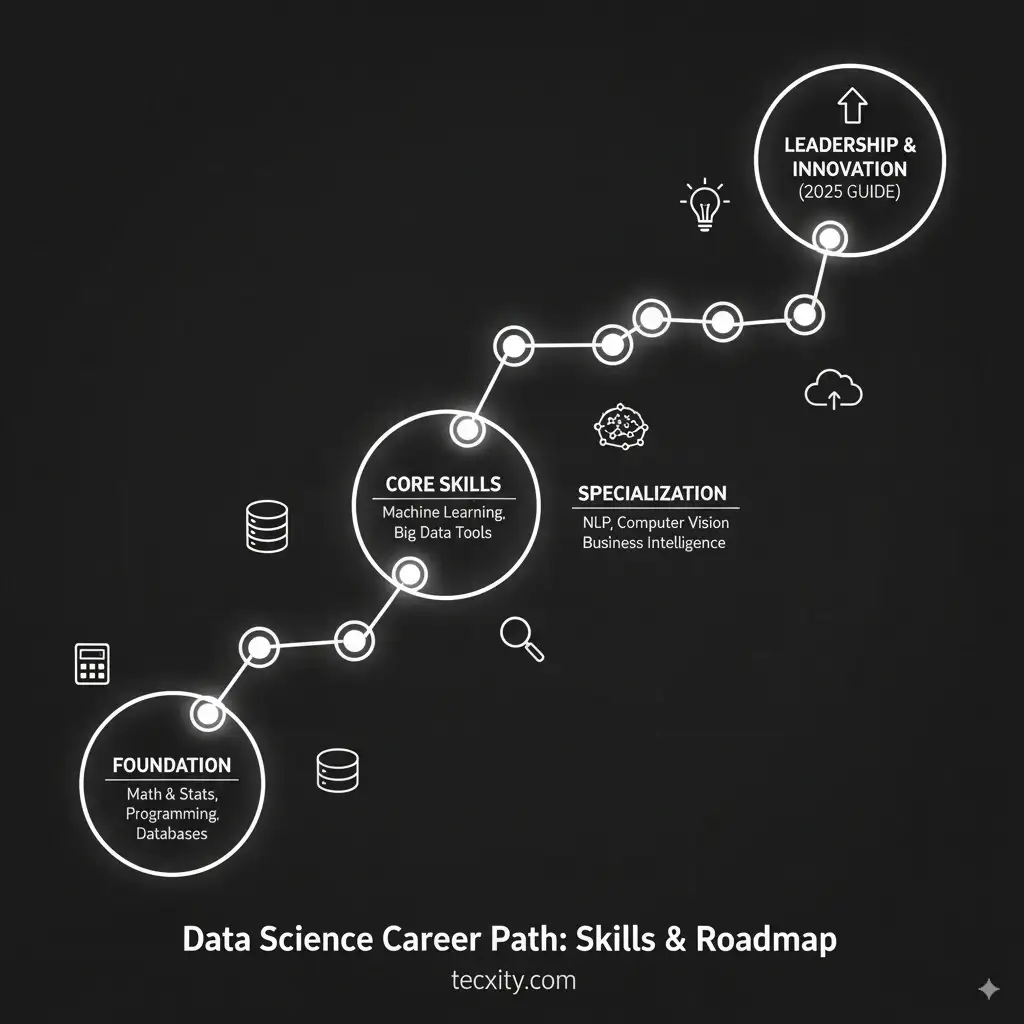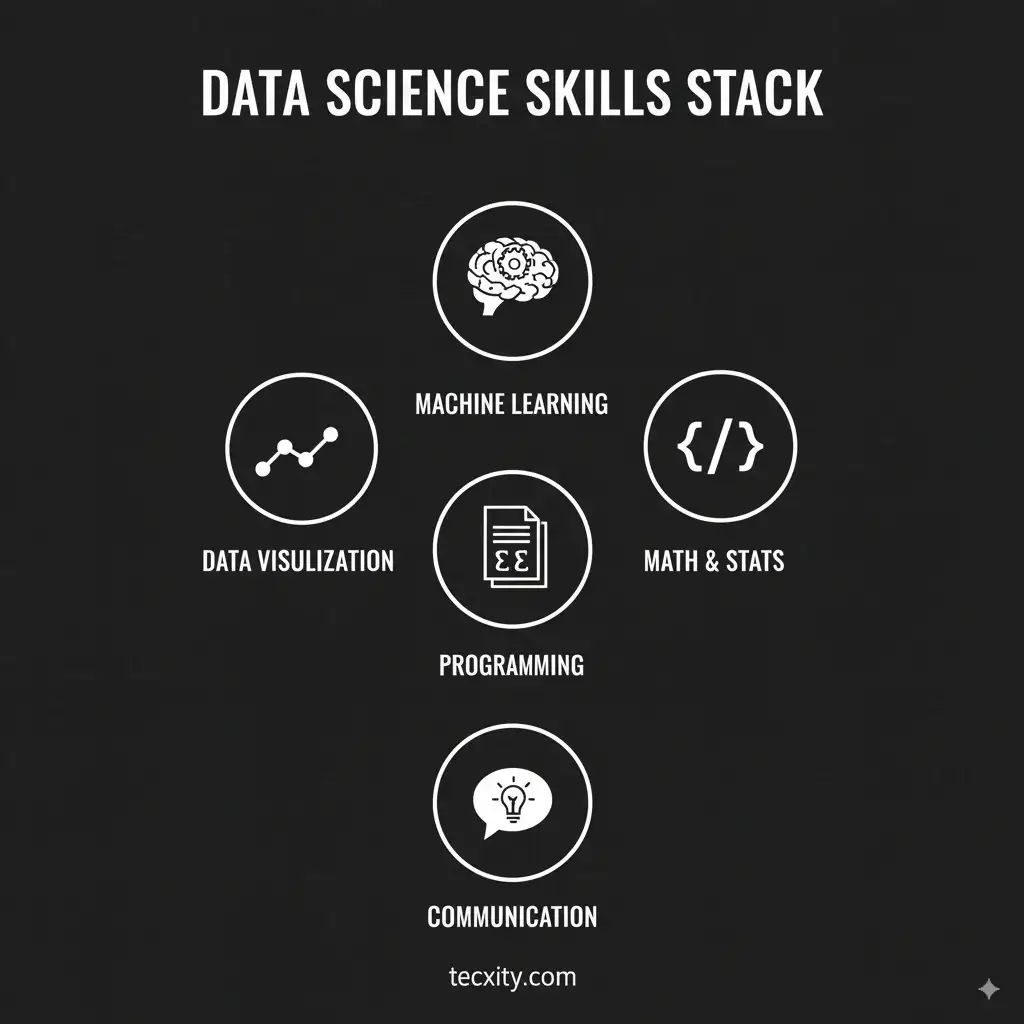
When we first heard the term Data Science, we imagined something out of a sci-fi movie, machines predicting the future, AI reading minds, and Netflix magically knowing which movie we watch on Friday night. Little did we know, it was all powered by data science, analyzing massive datasets, finding patterns, and making intelligent predictions.
If you’re curious about starting a career in data science, or even thinking about switching careers, this guide is for you. We will walk you through the step-by-step career path, must-have skills, essential tools, and practical roadmap, all in a way that feels less like a textbook and more like a conversation.
Why a Career in Data Science Makes Sense in 2025
Here’s the reality: data is everywhere. Every Google search, every Amazon purchase, every Instagram like it’s all data. And businesses are desperate for people who can turn that data into actionable insights.
- High Demand: Organizations across finance, healthcare, tech, retail, and even sports need data professionals.
- Attractive Salaries: Entry-level roles start around $70k–$90k, with mid-career roles easily exceeding $120k–$150k.
- Diverse Opportunities: Data Scientist, ML Engineer, Data Analyst, AI Specialist, there’s a role for everyone.
- Future-Proof Skills: AI, machine learning, and automation are reshaping industries, so your expertise will remain in demand.
The Data Science Career Path: Step-by-Step
Think of this as climbing a mountain each skill you learn is like a new piece of gear, and every project you complete brings you closer to the peak.

Step 1: Build Your Foundation
Before you write a single line of code, you need a strong foundation:
- Mathematics & Statistics: Probability, linear algebra, and statistics. Even basic understanding helps in analyzing trends.
- Programming Basics: Python is the most beginner-friendly language for data science. R is useful but secondary.
- Data Handling: Learn to work with spreadsheets and SQL databases.
Practical Example: One friend of mine automated Excel reporting at his job using Python. Within six months, he progressed to analyzing real datasets and building simple predictive models.
Step 2: Data Cleaning and Analysis
Most of a data scientist’s time is spent cleaning messy data.
- Tools: Python libraries like Pandas, NumPy, Matplotlib, and Seaborn.
- SQL: Essential for querying databases.
- Practice: Download a messy dataset from Kaggle, clean it, and generate visual insights.
Why it matters: Clean, structured data is the fuel for accurate models. Without it, even the smartest algorithms fail.
Step 3: Machine Learning & AI Basics
Here’s where the magic happens, teaching machines to “learn” from data.
- Supervised Learning: Predict outcomes (spam emails, customer churn).
- Unsupervised Learning: Detect patterns (customer segmentation, market trends).
- Deep Learning: Neural networks, CNNs, RNNs, Transformers for NLP or computer vision.
Story: Netflix recommending your favorite show? Amazon suggesting products? That’s machine learning in action.
Step 4: Data Visualization & Storytelling
You can have the best model in the world, but if you can’t explain it, it’s worthless.
- Tools: Tableau, Power BI, or Python libraries.
- Tip: Use visuals to tell a story, highlight insights, trends, and actionable points.
Example: Instead of showing a table of 10,000 rows, present a dashboard showing customer churn trends, colored by risk levels. Your boss will thank you.
Step 5: Domain Knowledge
Data science isn’t just about coding you must understand the business.
- Finance → fraud detection, stock prediction
- Healthcare → medical diagnostics, predictive analytics
- Marketing → customer segmentation, sales forecasting
Tip: Choose an industry early and learn its language, regulations, and challenges. It will make your models more accurate and your insights more actionable.
Step 6: Build a Portfolio & Projects
Your portfolio is your ticket to landing a job.
- Projects: Kaggle competitions, GitHub repositories, personal case studies.
- Showcase: Blog posts or LinkedIn updates explaining what you did and why it matters.
Example: Build a project predicting house prices, showing data cleaning, feature engineering, model selection, and results visualization. Employers love tangible proof.
Step 7: Networking & Job Hunt
Even the best portfolio won’t get noticed without networking.
- Join meetups, hackathons, online communities like Kaggle and LinkedIn groups.
- Practice interviews with SQL queries, ML case studies, and coding challenges.
- Resume tip: Focus on impact. “Improved churn prediction accuracy by 15% using a random forest model” is stronger than “Built a model to predict churn.”
Career Growth & Opportunities
Once you enter data science, growth is rapid if you stay updated:
- Entry → Data Analyst → Junior Data Scientist
- Mid → Data Scientist → ML Engineer → Senior Data Scientist
- Advanced → AI Specialist → Data Science Manager → Chief Data Officer
You can also pivot into product management or AI research, depending on interests.

Salary & Future Trends
- Entry-Level: $70k–$90k
- Mid-Level: $100k–$130k
- Senior-Level: $150k+
Future Trends: Generative AI, MLOps, and real-time analytics will continue to redefine the field. Skills in these areas will give you a competitive edge.
Common Beginner Mistakes
- Learning too many tools at once → focus on mastering Python + SQL first.
- Ignoring math & statistics basics → models need strong foundations.
- Studying theory only → projects matter more than tutorials.
- Weak networking → connections often lead to first opportunities.
Quick Visual Roadmap (Suggested for Your Blog Image)
Stepwise roadmap for readers to download or visualize:
- Foundations → Math, Python, SQL
- Data Handling → Cleaning, Visualization
- ML Basics → Supervised, Unsupervised
- Advanced AI → Deep Learning, NLP
- Portfolio → Projects, GitHub, Blogs
- Networking → Communities, LinkedIn
- Job Hunt → Interviews, Resume, Impact
A visual infographic can make this roadmap highly shareable on social media and boost engagement.
FAQs (Schema-Ready)
Q1: Do I need a degree to become a Data Scientist?
Not necessarily. Many successful data scientists are self-taught through bootcamps, online courses, and hands-on projects.
Q2: How long will it take to become a Data Scientist?
Typically 6–18 months, depending on your starting point and learning pace.
Q3: Which language is best for beginners?
Python is widely used, with SQL as a complementary skill.
Q4: Is Data Science harder than Software Engineering?
They require different strengths: Data Science focuses on analytics and statistics; Software Engineering emphasizes system design and development.
Q5: What’s the future of Data Science careers?
AI, generative models, MLOps, and ethical AI will drive opportunities. Staying updated is key to future-proofing your career.
Conclusion
Data Science is not just a job; it’s a mindset. You learn to see patterns where others see chaos, turn raw numbers into actionable insights, and create solutions that impact businesses and people.
Whether you’re just starting out or looking to level up, follow this roadmap, build your skills, showcase projects, and stay curious. Your journey may be challenging, but the destination, a rewarding, impactful career, is absolutely worth it.
Remember: every expert was once a beginner. The question is, will you start your journey today?
